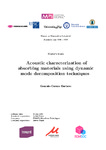Mostrar o rexistro simple do ítem
Acoustic characterization of absorbing materials using dynamic mode decomposition techniques
| dc.contributor.advisor | Prieto Aneiros, Andrés | |
| dc.contributor.advisor | Nayak, Ashwin | |
| dc.contributor.author | Carazo Barbero, Gonzalo | |
| dc.contributor.other | Universidade da Coruña. Facultade de Informática | es_ES |
| dc.date.accessioned | 2020-07-31T15:21:17Z | |
| dc.date.available | 2020-07-31T15:21:17Z | |
| dc.date.issued | 2020-07-21 | |
| dc.identifier.uri | http://hdl.handle.net/2183/26069 | |
| dc.description.abstract | [Abstract] In general, the simulation of physical phenomena through numerical methods tends to be a computationally intensive task, but this is particularly true in the eld of acoustics. Due to the fast changing derivatives and the innately second order formulation, a ne mesh needs to be used, and in order for the time discretization to be well behaved, a small time step needs to be chosen as well. In addition to this, the testing of acoustic propagation in a single domain is rarely of interest, since most applications involve the design of acoustic barriers or transmitters, which means that most problems solved in the eld involve couplings. One of the coupled mediums is usually a uid, and it is common for the other to be a porous material since they are the most e ective sound absorbers. It is in fact because of this absorption that the porous models can get very complex. Time convolutions are usually needed for the modeling of high frequency noise, which makes the simulation process very costly. It becomes apparent that a reduced order method that is able to cut the computation time down is a worthwhile tool to have. Among the reduced order methods (ROMs) the chosen one is a method that is able to make predictions into the future from a reduced amount of snapshots. Dynamic Mode Decomposition (DMD) is a technique developed in 2010 by Peter Schmid [47]. It is based on a Singular Value Decomposition (SVD) into which dynamics are added, making it able to not only reconstruct available data using a reduced order representation, but also able to expand the dimensionality in the time dimension in order to make predictions about the future. This means that a simulation spanning a shorter time can be run and the remaining sector of the time domain can be predicted by DMD, which adds up to a signi cantly faster process. DMD is a data-driven method, which means that no information about the dynamic model is needed, only a series of snapshots are used. It has been used in the uid dynamics community, where it originated, and a number of elds including video processing [21, 14], epidemiology [41] and neuroscience [5]. A number of acoustic models are developed in this work, and then, they are used to test the capabilities of DMD in acoustic problems and to nd its limitations. The motivation of this problem arises from a collaboration between the Technological Institute for Industrial Mathematics (ITMATI) and Micro own Technologies through the ROMSOC project. Together they started a project that became Ashwin Nayak's PhD thesis, in which the objective is to design a multilayer windshield for an acoustic probe by modeling the acoustic eld both inside and outside of the windshield considering acoustic and other physical phenomena such as uid, thermal and poro-elastic e ects in an unbounded domain. The present master thesis project reduces Nayak's problem to a 1D simpli ed problem and attempts to develop a method that could be, in the future, generalized to his problem and reduce the computation time needed. | es_ES |
| dc.language.iso | eng | es_ES |
| dc.rights | Os titulares dos dereitos de propiedade intelectual autorizan a visualización do contido deste traballo a través de Internet, así como a súa reproducción, gravación en soporte informático ou impresión para o seu uso privado e/ou con fins de estudo e de investigación. En nengún caso se permite o uso lucrativo deste documento. Estos dereitos afectan tanto ó resumo do traballo como o seu contido Los titulares de los derechos de propiedad intelectual autorizan la visualización del contenido de este trabajo a través de Internet, así como su repoducción, grabación en soporte informático o impresión para su uso privado o con fines de investigación. En ningún caso se permite el uso lucrativo de este documento. Estos derechos afectan tanto al resumen del trabajo como a su contenido | es_ES |
| dc.subject | Acoustic | es_ES |
| dc.subject | Acoustic propagation | es_ES |
| dc.subject | Numerical methods | es_ES |
| dc.title | Acoustic characterization of absorbing materials using dynamic mode decomposition techniques | es_ES |
| dc.type | info:eu-repo/semantics/masterThesis | es_ES |
| dc.rights.access | info:eu-repo/semantics/openAccess | es_ES |
| dc.description.traballos | Traballo fin de mestrado (UDC.INF). Matemática industrial. Curso 2019/2020 | es_ES |






